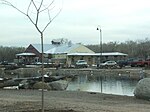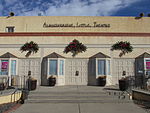ABQ BioPark Botanic Garden

The ABQ Biopark Botanic Garden is a 36-acre (15 ha) botanical garden located at 2601 Central Avenue NW in Albuquerque, New Mexico, beside the Rio Grande. The garden showcases plants of the Southwest and other arid climates, and includes a 10,000-square-foot (930 m2) conservatory. One wing of the glass conservatory houses plants native to the Mediterranean climates zones of Spain, Portugal, Turkey, South Africa, Australia, Chile and California. A second wing features xeric plants from North American deserts. The garden also features various exhibitions showcasing plants of different local habitats in New Mexico, medicinal plants, a butterfly pavilion and other attractions. The Garden's design was awarded as the 2019 Architecture + Community Award by the New Mexico Architectural Foundation.
Excerpt from the Wikipedia article ABQ BioPark Botanic Garden (License: CC BY-SA 3.0, Authors, Images).ABQ BioPark Botanic Garden
Central Avenue Northwest, Albuquerque Old Town
Geographical coordinates (GPS) Address Nearby Places Show on map
Geographical coordinates (GPS)
| Latitude | Longitude |
|---|---|
| N 35.0933 ° | E -106.6813 ° |
Address
ABQ BioPark: Zoo, Aquarium, Botanic Garden
Central Avenue Northwest 2601
87102 Albuquerque, Old Town
New Mexico, United States
Open on Google Maps










